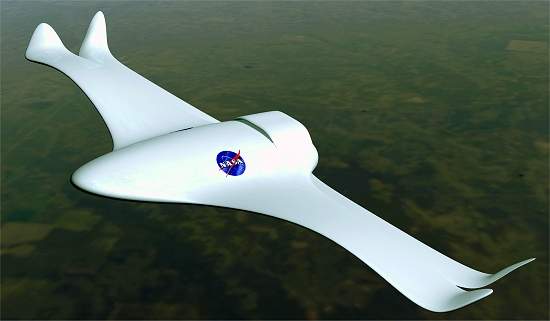
Compósitos são materiais híbridos, resultantes da mistura de polímeros com materiais naturais, metais, fibras ou cerâmicas.
Os
nanocompósitos são materiais desse tipo, mas cuja estrutura é projetada e
sintetizada em nanoescala. Cientistas ligados à NASA estão agora
estudando uma nova série de nanocompósitos capazes de "reagir a
estímulos".

The combination of biologically inspired technology,
engineering and IT could allow 'morphing wing' aircraft to be developed,
offering huge operational benefits, improved efficiencies and enhanced
safety performance.
Materiais
reativos De forma semelhante a um ser vivo, por exemplo, afastando-se
rapidamente de uma fonte de calor, esses nanocompósitos reativos alteram
suas propriedades mecânicas quando expostos a campos elétricos, campos
magnéticos ou a algum tipo de radiação eletromagnética.
 |
| Airbus is exploring ways of both enhancing users experiences and creating a more environmentally friendly vehicle. Among their hypothetical thinking is a transparent panoramic membrane roof enabling seeing both airspace above and below the seating and in natural light. Notwithstanding 'intelligent' cabin wall membranes and interactive games, but also a new aircraft structure would allow for walls which control air temperature. |
A
alteração das propriedades desses "materiais mutantes" deriva de
interações sinergísticas entre a matriz de polímero e seu material de
preenchimento.
Os
pesquisadores agora conseguiram desenvolver um novo material com uma
capacidade de reação significativa a um campo elétrico, o que significa
que ele pode ser usado como atuador - para exercer uma força, por
exemplo - ou sofrer uma deformação.
É um passo gigantesco à frente dos músculos artificiais.
Aviões
que mudam de forma Um dos objetivos primários da pesquisa é o
desenvolvimento de aviões que possam se adaptar às condições de voo
alterando seu próprio formato - eles são chamados de aviões morfológicos
(morphing planes).
Por
exemplo, um avião precisa de grande sustentação nas baixas velocidades
de decolagem e pouso, mas isso compromete sua aerodinâmica para o voo em
alta velocidade. Hoje,
esse equilíbrio é obtido cedendo-se dos dois lados, o que significa que
os aviões não são ótimos em nenhuma das duas situações.

Alguns
sistemas de asas móveis tentam contornar esse compromisso, mas com um
custo e uma complexidade elevados demais para serem usados em aplicações
úteis - na aviação civil, por exemplo. Mas esses materiais adaptativos
são promissores para inúmeras outras aplicações, de stents e implantes
médicos a automóveis e telescópios.
Do nano ao macro
Os
maiores entraves ao uso desses materiais inovadores estão nas
restrições de temperatura e no fato de que os protótipos até agora
desenvolvidos suportam poucos ciclos de funcionamento - o que significa
que eles perdem sua capacidade de se "transformar" com o uso.
Os
pesquisadores descobriram que a saída pode estar no uso de nanotubos de
carbono no meio dos chamados nanocompósitos poliméricos
eletrorrestritivos (PNC: Electrostrictive Polymer Nanocomposites).
De
forma surpreendente, os pesquisadores descobriram que as nanopartículas
são essenciais para a construção dos materiais eletroativos, mas a
capacidade final do material para mudar de forma depende das suas
características finais em macroescala.
Os
resultados mostraram que a atuação eletrotermal do nanocompósito não
depende da composição do material que preenche a matriz de polímero, mas
apenas da condutividade final do material pronto - daí a importância
dos nanotubos de carbono, com sua excepcional condutividade.
O
trabalho estabelece um novo patamar para as pesquisas, permitindo que
os cientistas selecionem os melhores materiais de preenchimento,
calculem sua quantidade ótima e descubram novas técnicas de
processamento - tudo para otimizar o comportamento morfológico final do
material.
Confira mais ainda: The Personal Tilt-Rotor
FALX Air Hybrid Tilt-Rotor Chopper
An ambitious aircraft concept combines the speed of a plane, the agility of a helicopter and the efficiency of a hybrid car. (Pics)
Simon Scott, the owner of Falx Air, an aviation company based in Staffordshire, England, wants to revolutionize not just medevacs but all personal air transportation. A former communications specialist in the British Army’s Air Corps, Scott has been designing Falx Air’s hybrid-electric vertical-takeoff-and-landing (VTOL) craft for the past eight years. He’s currently bench-testing components in the hopes of getting a single-passenger prototype ready to be certified in January by the Civil Aviation Authority, Britain’s equivalent of the FAA.
The key to his design is a hybrid system that doesn’t rely on batteries to do most of the work. The engine powers two generators, which directly feed two electric motors on each wing. A battery pack stores leftover power from the generator but kicks in only to provide a power boost during takeoffs, landings and the transition to forward flying. It needs the huge burst of energy to get extra lift because the rotors on a VTOL have a smaller surface area than those on a traditional helicopter. “If you want to fly your aircraft for two hours, you cannot do that on batteries,” Scott says. “That’s the reason behind having the engine supply electricity continuously.”

Scott is finished with the design; now he just has to find parts that can make it real. Falx Air is testing a 104-horsepower, two-stroke engine, but it isn’t flight-certified yet. And although Scott is looking into lithium-iron-phosphate batteries, similar to one of the battery chemistries being tested for the Chevy Volt, his challenge is greater because the aircraft needs a bigger jolt of power than a car does.


Fonte: www.impactable.net/ Falx Air/ Voarnews - pesquisa&ilustration militanciaviva

Nenhum comentário:
Postar um comentário